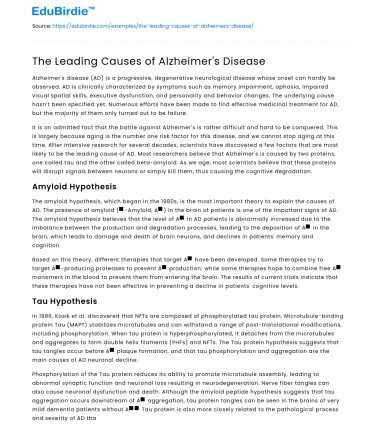Alzheimer's disease (AD) is a progressive, degenerative neurological disease whose onset can hardly be observed. AD is clinically characterized by symptoms such as memory impairment, aphasia, impaired visual spatial skills, executive dysfunction, and personality and behavior changes. The underlying cause hasn’t been specified yet. Numerous efforts have been made to find effective medicinal treatment for AD, but the majority of them only turned out to be failure.
It is an admitted fact that the battle against Alzheimer's is rather difficult and hard to be conquered. This is largely because aging is the number one risk factor for this disease, and we cannot stop aging at this time. After intensive research for several decades, scientists have discovered a few factors that are most likely to be the leading cause of AD. Most researchers believe that Alzheimer's is caused by two proteins, one called tau and the other called beta-amyloid. As we age, most scientists believe that these proteins will disrupt signals between neurons or simply kill them, thus causing the cognitive degradation.
Save your time!
We can take care of your essay
- Proper editing and formatting
- Free revision, title page, and bibliography
- Flexible prices and money-back guarantee
Amyloid Hypothesis
The amyloid hypothesis, which began in the 1980s, is the most important theory to explain the causes of AD. The presence of amyloid (β-Amyloid, Aβ) in the brain of patients is one of the important signs of AD. The amyloid hypothesis believes that the level of Aβ in AD patients is abnormally increased due to the imbalance between the production and degradation processes, leading to the deposition of Aβ in the brain, which leads to damage and death of brain neurons, and declines in patients' memory and cognition.
Based on this theory, different therapies that target Aβ have been developed. Some therapies try to target Aβ-producing proteases to prevent Aβ production; while some therapies hope to combine free Aβ monomers in the blood to prevent them from entering the brain. The results of current trials indicate that these therapies have not been effective in preventing a decline in patients' cognitive levels.
Tau Hypothesis
In 1986, Kosik et al. discovered that NFTs are composed of phosphorylated tau protein. Microtubule-binding protein Tau (MAPT) stabilizes microtubules and can withstand a range of post-translational modifications, including phosphorylation. When tau protein is hyperphosphorylated, it detaches from the microtubules and aggregates to form double helix filaments (PHFs) and NFTs. The Tau protein hypothesis suggests that tau tangles occur before Aβ plaque formation, and that tau phosphorylation and aggregation are the main causes of AD neuronal decline.
Phosphorylation of the Tau protein reduces its ability to promote microtubule assembly, leading to abnormal synaptic function and neuronal loss resulting in neurodegeneration. Nerve fiber tangles can also cause neuronal dysfunction and death. Although the amyloid peptide hypothesis suggests that tau aggregation occurs downstream of Aβ aggregation, tau protein tangles can be seen in the brains of very mild dementia patients without Aβ. Tau protein is also more closely related to the pathological process and severity of AD than Aβ. However, although tau-based treatment research has shown promising results, and seven tau-related treatments are currently undergoing phase II clinical trials, unfortunately, many anti-tau treatments have failed in clinical trials. Glycogen synthase kinase 3 beta (GSK-3β) is a protein kinase that promotes tau phosphorylation, making it an attractive target for anti-tau treatment options. However, Tideglusib, a GSK-3β inhibitor, has not shown significant therapeutic effects in phase II clinical trials.
Brain iron accumulation
Now, a new study from the University of California, Los Angeles suggests a third possible cause: iron accumulation. Professor George Bartzokis and his colleagues analyzed two regions in the brain of Alzheimer's patients. They compared the hippocampus (which is a well-known area that is damaged early in the disease) and the thalamus (this area is generally not damaged until the end of the disease). Using sophisticated brain imaging techniques, they found that the amount of iron was increased in the hippocampal region and that this was related to tissue damage in that region. But there was no increase in iron in the thalamus.
The destruction of the myelin sheath (adipose tissue covering nerve fibers in the brain) can affect the communication between neurons and promote the accumulation of plaque. These amyloid plaques in turn destroy more and more myelin sheaths, disrupt brain signals, and cause cell death and classic Alzheimer's clinical symptoms. Long-term research has supported that iron levels in the brain may be a risk factor for aging diseases such as Alzheimer's. Although iron is essential for cell function, too much of it may promote oxidative damage.
Studies have found that the amount of iron increases in the hippocampus and is associated with tissue damage in patients with Alzheimer's disease, but in healthy elderly individuals or in the thalamus, the amount of iron was not found to increase. Therefore, the results of the study suggest that the accumulation of iron may indeed contribute to Alzheimer's disease.
In addition to the three possible causes mentioned above, there are other suspects that are to be blame such as lifestyle, exercise, diet, etc. It may take longer time to crystalize the real culprit of AD.






 Stuck on your essay?
Stuck on your essay?

